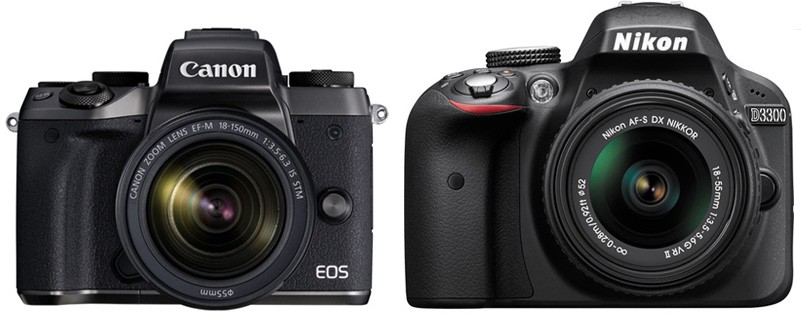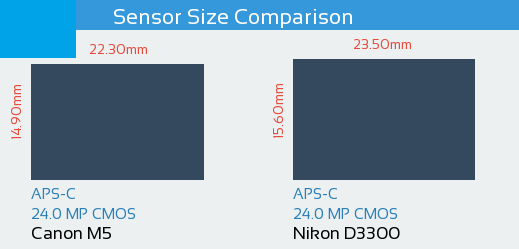Canon M5 vs Nikon D3300
: We compare the Canon M5, a Semi-Pro Mirrorless camera with a 24.0MP APS-C sensor and the Nikon D3300, an Entry-Level DSLR camera with a 24.0MP APS-C sensor. Before we go in-depth, here’s a brief overview of the main specs of both cameras.
Canon M5 vs Nikon D3300 Specs
The Canon M5 is a Semi-Pro Mirrorless camera whereas Nikon D3300 is a Semi-Pro DSLR camera. The difference here lies in the body type. Mirrorless cameras are much more lightweight than their DSLR counterparts. However, DSLRs have been known to perform better than most mirrorless cameras. But, with recent advancements in focus speeds and design, mirrorless cameras serve as good alternatives to DSLRs.

Canon M5 vs Nikon D3300
Specifications |
Canon M5 |
Nikon D3300 |
|---|---|---|
| Megapixels | 24.2 | 24.2 |
| Sensor Type | CMOS | CMOS |
| Sensor Format | APS-C | APS-C (DX) |
| Crop Factor | 1.6x | 1.5x |
| AA Filter | Yes | None |
| Image Resolution | 6000 x 4000 | 6000 x 4000 |
| Body Image Stabilization | Yes (Movie only) | No |
| Lens Mount | Canon EF-M | Nikon FX/DX |
| ISO | 100 – 25,600 | 100 – 12,800 |
| Expanded ISO | None | 25,600 |
| AF Points | 49 Hybrid | 11 |
| Cross-type AF Points | Dual Pixel AF | 1 |
| Continuous Mode | 7fps | 5fps |
| LCD | 3.2″ – Articulating | 3.0″ – Fixed |
| LCD Resolution | 1,620,000 dots | 921,600 dots |
| Touchscreen | Yes | No |
| Focus Peaking | Yes | No |
| Top LCD Display | No | No |
| Viewfinder Type | EVF (2.36M) | Optical |
| Viewfinder Coverage | 100% | 95% |
| Viewfinder Magnification | 0.85x | |
| Video Resolution | 1920×1080 (60/50/30/25/24p | 1920×1080 (60/50/30/25/24p |
| 1280×720 (60/50p) | 1280×720 (60/50p) | |
| Microphone Jack | Yes | Yes |
| Headphone Jack | No | No |
| Memory Card Type | SD | SD |
| Dual Card Slots | No | No |
| SD UHS Support | UHS-I | UHS-I |
| Fastest Shutter Speed | 1/4000 | 1/4000 |
| Slowest Shutter Speed | 30″ | 30″ |
| Bulb Mode | Yes | Yes |
| JPEG Buffer Size | 27 | 100 |
| RAW Buffer Size | 18 | 7 |
| Time Lapse | Yes | No |
| Built-in Flash | Yes | Yes |
| Max Flash Sync Speed | 1/200 | 1/200 |
| Startup Time | 1.2s | 0.4s |
| Built-in Wi-Fi | Yes | No |
| Built-in GPS | No | No |
| Built-in NFC | Yes | No |
| Bluetooth | Yes | No |
| USB Type | USB 2.0 | USB 2.0 |
| Environmentally Sealed | No | No |
| Battery Life (CIPA) | 295 shots | 700 shots |
| Battery Included | Yes (LP-E17) | Yes (EN-EL14a) |
| Weight | 15.0 oz (427g) | 13.93 oz (395g) |
| Size | 4.6 x 3.5 x 2.4″ | 4.9 x 3.9 x 3.0″ |
| Price | Amazon | Amazon |
| Release Date | 2016 | 2014 |
Nikon D3300 vs Canon M5: Common Features
| Built-in Flash | Yes vs Yes | Useful in low-light |
| External Flash Shoe | Yes vs Yes | Better for flash photography |
| Viewfinder | Yes (Electronic) vs Yes (Optical) | Better framing and control |
| RAW Support | Yes vs Yes | Better image quality |
| Face Detection Focus | Yes vs Yes | very handy for portraits |
| Max Resolution | 24 MP vs 24 MP | Bigger prints and more details |
| Microphone Port | Yes vs Yes | High-quality audio recording option |
Canon M5 vs Nikon D3300 Size Comparison
The Canon M5 is certainly the smaller of the two cameras. Its body is 8mm narrower, 9mm shorter and 15mm thinner than the Nikon D3300.
Weight is another important factor to consider when buying a camera. The M5 is lighter by 3g. This weight difference is not significant for everyday use.

Canon M5 vs Nikon D3300
Also, keep in mind that the lenses that you use with these bodies may affect the overall weight. However, since both the Canon EOS M5 and Nikon D3300 have the same APS-C sized sensor, their lenses with regard to similar focal length and aperture are similar in size and weight.
Nikon D3300 vs Canon M5 Sensor Comparison
Both the D7200 and A6300 have APS-C sized 24.0 MP resolution sensors. So, sensor size and resolution should not influence your choice between the two cameras.
Another key difference between these two cameras is that the Nikon D3300’s sensor lacks an anti-alias (Low-Pass) filter. Removing the anti-alias filter increases the sharpness and level of detail but, at the same time, it increases the chance of watery overlays occurring in certain pictures.

Canon EOS M5 vs Nikon D3300 Sensor Comparison
The Nikon D3300 has a 1.1x larger sensor area than the Canon M5. Larger sensors allow for more control of the depth of field and blurry background compared to the smaller sensor when shot in same focal length and aperture.
Canon EOS M5 Advantages Over Nikon D3300
| Wireless Connection | Built-In vs Optional | Better connectivity |
| Articulating Screen | Yes vs No | Flexible shooting positions |
| Touch Screen | Yes vs No | Easy control of camera functions |
| Max ISO | 25.600 vs 12.800 | 100% higher Max ISO |
| Number of Focus Points | 49 vs 11 | 38 more focus points |
| LCD Screen Size | 3.2″ vs 3″ | 0.2 inches larger display |
| LCD Screen Resolution | 1.620k dots vs 921k dots | 75% higher resolution screen |
| Viewfinder Coverage | 100% vs 95% | More accurate viewfinder |
| Continuous Shooting | 9.0fps vs 5.0fps | 4 fps faster |
| Weight | 427 g vs 430 g | 3 g lighter |
| Timelapse Recording | Yes vs No | creative shooting |
| AE Bracketing | Yes vs No | Useful for tough lighting conditions and HDR |
| Selfie Friendly LCD | Yes vs No | Rotate LCD for taking Selfies |
| NFC Connection | Yes vs No | Easy wireless connectivity with compatible devices |
| Bluetooth | Yes vs No | Connect your camera to other devices via Bluetooth |
| Smartphone_remote control | Yes vs No | Remote control your camera with a smartphone |
| Digital video stabilization | Yes vs No | Stabilizes your videos in-camera |
Key reasons to choose the Canon M5 instead of the Nikon D3300:
- Body Image Stabilization – It has body image stabilization but it only works in video.
- AF Points – 39 vs 11
- Continuous mode – 7fps vs 5fps. More is better for sports and wildlife since you have more chances of getting a tack sharp shot.
- LCD – 3.2″ vs 3.0″ and it’s articulated.
- LCD Resolution – Higher resolution.
- Touchscreen Support
- Focus Peaking – Very useful for seeing if your subject is in focus (both photo and video).
- Viewfinder Coverage – 100% vs 95%.
- RAW Buffer Size – 18 vs 7.
- Time-Lapse
- Built-in Wi-Fi
- Built-in NFC
- Bluetooth Support
- Size – The Canon M5 is noticeably smaller.
Video: Canon M5 Hands-on Review
Nikon D3300 Advantages Over Canon EOS M5
| Battery Life | 700 shotsvs295 shots | 405 more frames with a single charge |
| Flash Coverage | 12.0mvs5.0m | 7m longer range |
| Sensor Pixel Area | 15.28µm2vs13.84µm2 | 10% larger pixel area |
| Price | $447vs$929 | $482 cheaper |
Here are the key reasons to buy the D3300 instead of the M5:
- AA Filter – The Nikon D3300 has no AA filter.
- JPEG Buffer Size – 100 vs 27. Useful for long bursts.
- Battery Life – 700 shots vs 295 shots.
You can check out the best accessories and lenses for the Nikon D3300 while you’re here. And, we also have an article on the top SD card to use.